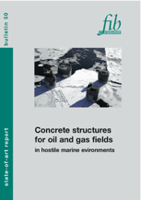Concrete structures for oil and gas fields in hostile marine environments
fib Bulletin No. 50
Title: Concrete structures for oil and gas fields in hostile marine environments.
Category: State-of-art report
Year: 2009
Pages: 36
Format approx. DIN A4 (210x297 mm)
ISBN: 978-2-88394-090-1
Abstract:
Concrete offshore structures have been successfully delivered to the international oil and gas industry for more than 35 years. Some 50 major concrete platforms of different shapes and sizes, supporting large production and storage facilities, are currently operating in hostile marine environments worldwide and have excellent service records.
After some years with little development activity, today there is a renewed interest in robust structures for the Arctic environment, for Liquefied Natural Gas (LNG) terminals and for special floating barges and vessels. Currently, concrete solutions are being considered for projects north and east of Russia, north of Norway and offshore Newfoundland, among others.
Concrete is also in increasing demand in built up coastal areas for a variety of purposes such as harbour works, tunnels and bridges, cargo terminals, parking garages and sea front housing developments where durability and robustness are essential.
The mandate of fib Task Group 1.5 was to gather the experience and know-how pertinent to the development, design and execution of offshore concrete structures, and to elaborate on the applicability of concrete structures for the Arctic environments. The findings of the Task Group are presented in fib Bulletin 50.
The report is based on experience gained from the design, execution and performance of a number of offshore concrete structures around the world and in particular in the North Sea. Ongoing inspections have shown excellent durability and structural performance, even in structures that have exceeded their design lives, in conditions often characterized by extreme wave loads, freezing conditions, hurricane force winds and seismic actions. This forms the "background" for discussing the applicability of concrete structures for the Arctic regions.
Although to a large extent dedicated to oil- and gas- related structures, the report is also relevant to other marine applications where the same design principles, material selection criteria and construction methods apply.
fib Bulletin 50 is not in itself a code, nor is it a textbook. Rather, extensive reference is made to proven and readily available design codes and construction guides, as well as relevant papers and proceedings and other fib publications.
Download the copyright page (= list of authors) as a PDF file.
Download the table of contents as a PDF file.



